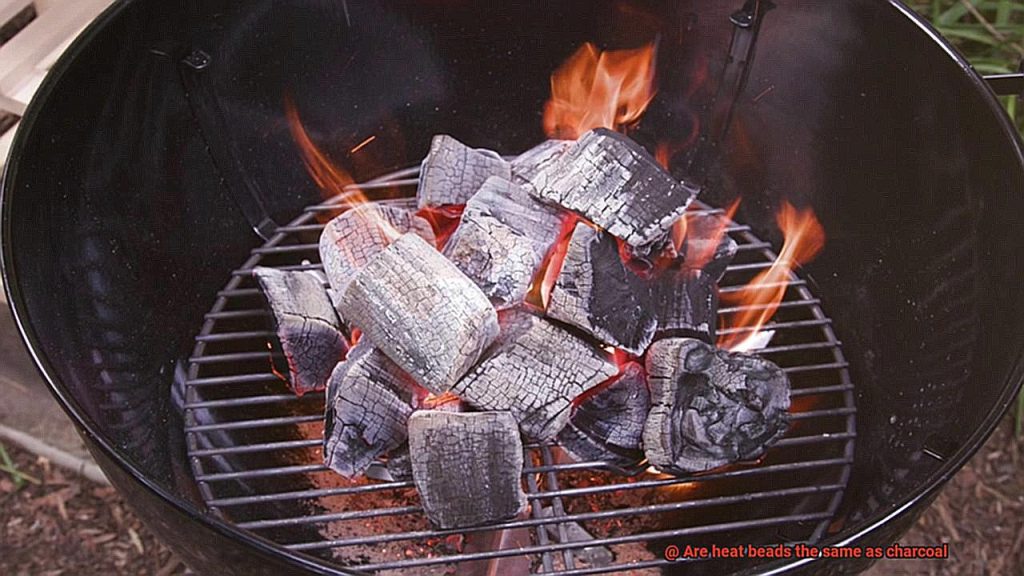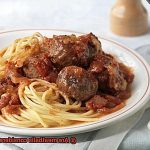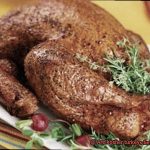Outdoor cooking is all about the fuel you use for your grill. It’s the key factor that determines how your food will taste and whether it’ll be a hit or miss. Charcoal has been the go-to fuel for grilling and barbecuing for ages, but there’s a new contender in town: heat beads. If you’re wondering whether heat beads are the same as charcoal and if they’re any good, then this post is for you.
At first glance, heat beads and charcoal may look alike, but they’re not identical twins. They both provide heat and that smoky flavor to your meals, but their composition and burning properties differ. Heat beads are made from compressed sawdust, while charcoal is derived from natural wood. This dissimilarity affects how long they burn and how much heat they produce.
So, let’s answer the million-dollar question: Are heat beads the same as charcoal? The short answer is nope. However, that doesn’t mean one is superior to the other. Your choice depends on your preference and cooking style. In this post, we’ll explore the differences between heat beads and charcoal in depth, including their pros and cons. By the end of it all, you’ll have an informed decision on which fuel suits your grilling needs best.
Ready to dive into the world of outdoor cooking fuel? Let’s get started.
Contents
What are Heat Beads?
Crafted from a blend of high-quality hardwood charcoal, mineral carbon, and a touch of starch binder, Heat Beads are compressed into small, pillow-shaped briquettes that offer an unmatched performance. These briquettes are easy to light and burn longer and hotter than traditional charcoal, ensuring you spend more time cooking and less time fussing over the temperature.
One of the most significant benefits of Heat Beads is their consistent heat output. Unlike traditional charcoal that can have hot spots and uneven temperatures, Heat Beads burn evenly and maintain a steady temperature throughout the cooking process. This makes them ideal for slow-cooking meats or smoking foods, allowing you to achieve that perfect, mouthwatering flavor.
In addition to their consistent heat output, Heat Beads produce minimal ash. As the briquettes burn, they generate very little waste, significantly reducing the need for frequent cleaning of the grill or barbecue. This not only makes them more environmentally friendly than traditional charcoal but also saves you time and effort.
To sum it up, Heat Beads are an excellent alternative to traditional charcoal for outdoor cooking. Here’s why:
- They provide consistent heat output
- They burn longer and hotter
- They produce less ash
- They are easy to light
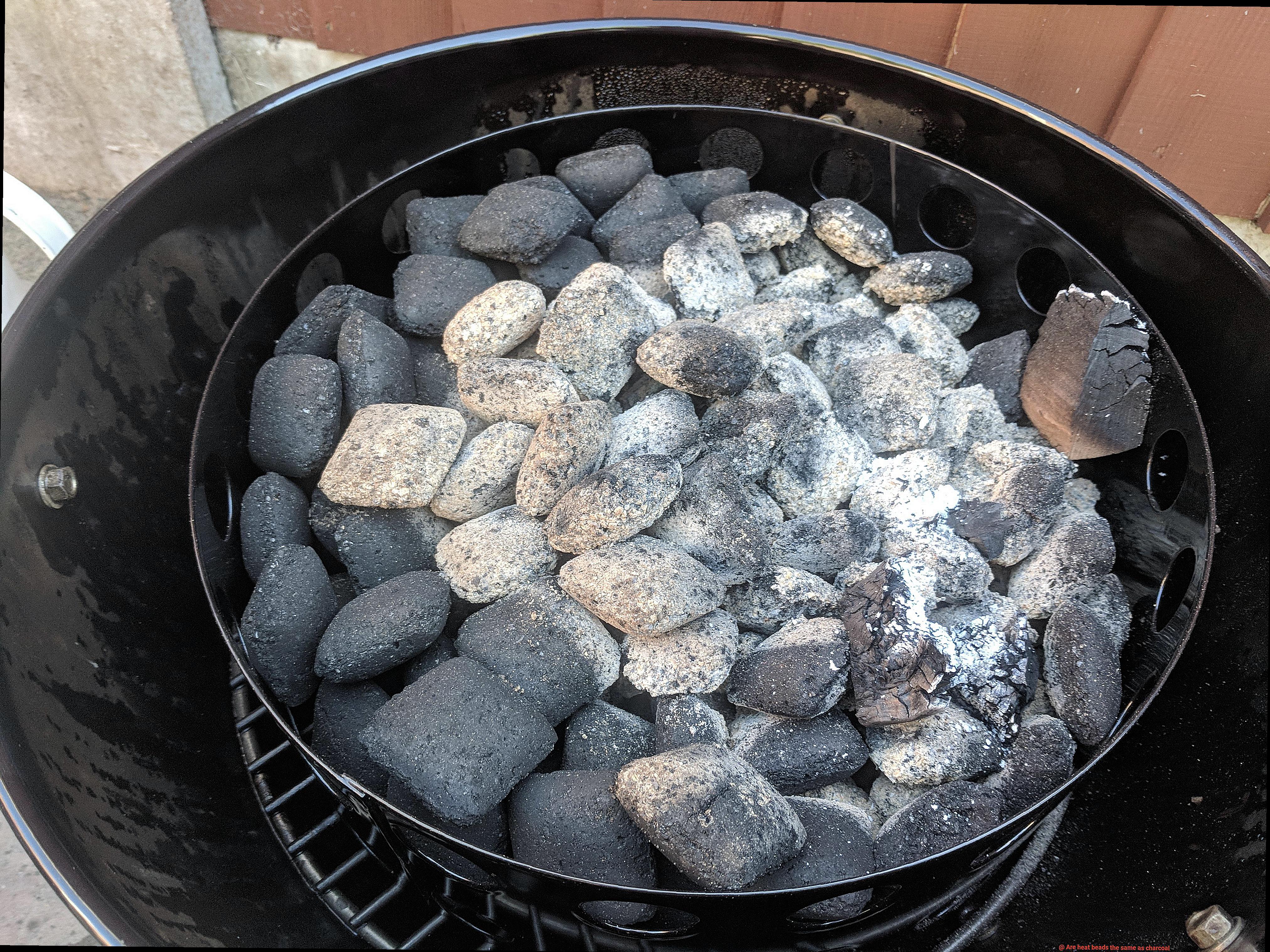
What is Charcoal?
If you’re a fan of outdoor cooking, you’ve likely encountered charcoal at some point. But do you know what it actually is? Charcoal is a remarkable fuel source that has been used for centuries in various ways.
Firstly, charcoal is a black, porous material that’s created by burning wood in the absence of oxygen. During this process, water, sap, and other impurities are removed from the wood, leaving behind a highly concentrated fuel source that burns hotter and longer than regular wood. This property makes it an ideal source of heat for cooking and heating.
There are two main types of charcoal: lump charcoal and briquettes. Lump charcoal is made by burning hardwood in a kiln until it turns into charcoal. It’s known for its natural flavor and high heat output, which makes it perfect for grilling or smoking meat. It can be more expensive than briquettes, but its superior quality is worth the price.
Briquettes, on the other hand, are made by compressing sawdust and other wood scraps with a binder until they form uniform pieces. They’re cheaper than lump charcoal and burn more consistently, making them a popular choice among outdoor cooking enthusiasts. However, they may contain additives that affect the taste of your food.
When it comes to choosing charcoal for your grill or smoker, it’s crucial to opt for a high-quality product from a reputable brand. Some companies may use lower quality wood or add fillers to their products, which can negatively impact the flavor and quality of your food. Therefore, it’s essential to do your research and choose wisely.
How Do They Burn Differently?
If so, you’ve probably heard of heat beads and charcoal as two popular fuel sources. While they may look similar, these fuels burn differently due to their unique compositions. As an expert on the topic, I’m here to give you the scoop on how they differ and which one is best for your grilling needs.
Let’s start with what these fuels are made of. Charcoal is produced by heating wood in an oxygen-free environment, which removes water and other volatile compounds, leaving behind pure carbon. Heat beads, on the other hand, are made from compressed sawdust mixed with a binder like starch. This difference in composition gives them distinct advantages when it comes to grilling.
Charcoal burns hotter and faster than heat beads, making it perfect for searing steaks or cooking foods that require high heat. Its quick burn time is also great for those who want to get their grilling done quickly. On the other hand, heat beads burn at a lower temperature and for a longer period of time, making them ideal for slow-cooking meats or smoking foods. So if you’re planning on doing some low and slow cooking, heat beads are the way to go.
Another important factor to consider is the amount of ash produced by each fuel source. Heat beads produce less ash than charcoal, which means less mess to clean up after grilling. Plus, heat beads are made from recycled sawdust, making them a more environmentally friendly option compared to charcoal.
In summary, if you’re looking to cook at high heat and want a quick burn time, charcoal is the way to go. But if you’re planning on slow-cooking or smoking food and want a cleaner grill with less ash, heat beads are the better option. Don’t forget to choose a high-quality product from a reputable brand to ensure the best flavor for your food.
Chemical Makeup Differences
One essential factor to consider is the chemical makeup differences between heat beads and charcoal.
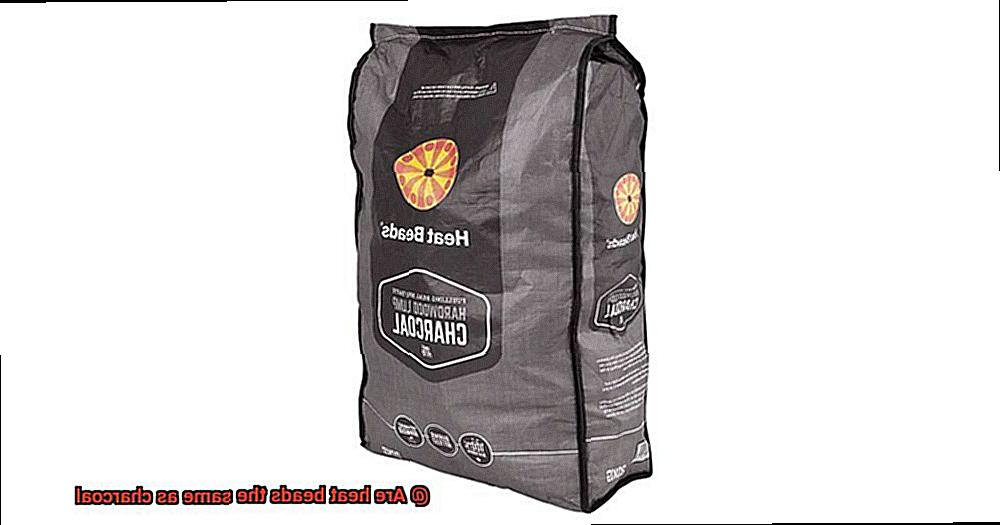
Charcoal is made by partially burning wood in a low-oxygen environment, which removes water and volatile compounds, leaving behind carbon-rich material. Due to its high carbon content and fewer impurities, charcoal burns hotter and faster than heat beads. On the other hand, heat beads are made from powdered coal, limestone, and starch. The coal used in heat beads is typically lower quality than charcoal’s wood and has been ground into a fine powder. Limestone acts as a binding agent, while starch holds the mixture together during manufacturing. Due to their uniform size and shape, heat beads burn more consistently and for more extended periods.
Apart from their burn characteristics, these fuels differ in the amount of ash they produce. Heat beads tend to produce less ash than charcoal because they contain fewer impurities. This makes them a more convenient option for grillers who don’t want to spend as much time cleaning up after cooking.
But which one should you choose? It depends on your grilling needs. If you’re looking for a quick burn for searing steaks or grilling burgers, charcoal may be your best bet. However, if you’re planning on slow-cooking meats or smoking foods, heat beads may be the way to go.
To help you achieve optimal cooking results, here are some key takeaways:
- Charcoal burns hotter and faster due to its high carbon content and fewer impurities.
- Heat beads burn more consistently and for longer periods due to their uniform size and shape.
- Heat beads produce less ash than charcoal because they contain fewer impurities.
- Choose your fuel based on your grilling needs: quick burn for searing or slow-cooking meats.
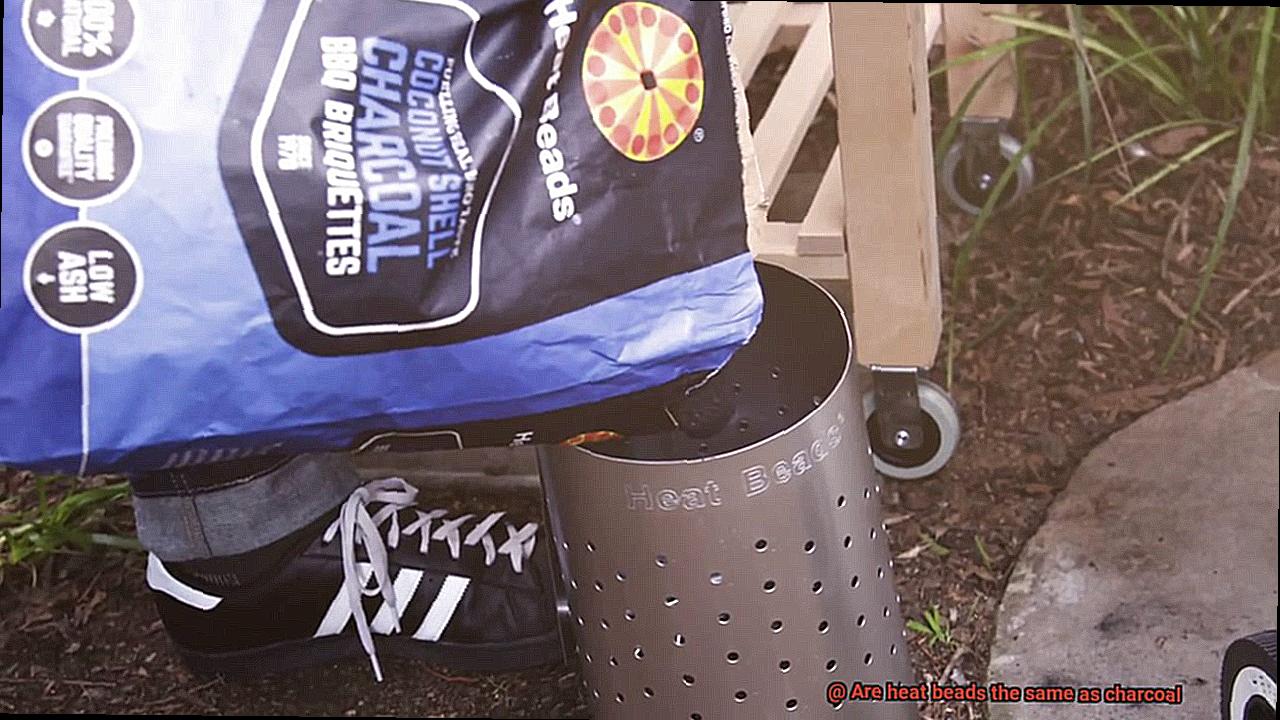
Environmental Impact of Heat Beads vs Charcoal
When it comes to grilling, the fuel source you choose can make all the difference in the quality of your meal. But have you ever considered the environmental impact of your fuel choice? Let’s compare heat beads vs charcoal to understand their environmental impact.
Charcoal has been the traditional fuel source for grilling for many years. However, its production has been criticized for contributing to deforestation and creating air pollution. Charcoal is made by burning wood in a low-oxygen environment, which releases harmful pollutants into the air. In contrast, heat beads are made from compressed sawdust, producing less smoke and ash compared to charcoal.
Heat beads are a more sustainable option since they are made from waste wood products. The manufacturing process of heat beads requires less energy and produces fewer greenhouse gas emissions compared to traditional charcoal production. This makes heat beads a better option for those who want to minimize their environmental impact.
But both heat beads and charcoal release carbon dioxide when burned, contributing to climate change. Additionally, lighter fluids or chemicals used to ignite them can release harmful pollutants into the air. To minimize their impact, it’s crucial to use natural fire starters instead of lighter fluids or chemicals.
So, what can we do to reduce our environmental impact while grilling? Here are some tips:
- Choose a high-quality grill that burns fuel efficiently to reduce the amount of fuel needed for grilling.
- Use natural fire starters instead of lighter fluids or chemicals to light your fuel source.
- Consider using heat beads as a more sustainable option than traditional charcoal.
- Recycle your grill and dispose of used charcoal or heat beads properly.
Pros and Cons of Using Heat Beads and Charcoal for Grilling
The fuel source you choose can make or break your outdoor cooking experience, so it’s important to weigh the pros and cons of each option before you fire up the grill. Let’s dive into the world of heat beads and charcoal and explore what makes each of them a great choice for your next BBQ.
Starting with charcoal – this fuel source is a popular choice among grilling enthusiasts because it burns hotter than other fuels, which means you can achieve that perfect sear on your steak or burger. Charcoal also imparts a smoky flavor on your food that many people find irresistible. However, lighting charcoal can be challenging, and controlling the temperature can be tricky. Additionally, charcoal tends to burn faster than other fuels, requiring you to add more fuel during the cooking process. It also produces some ash which can be messy and difficult to clean up.
Now let’s talk about heat beads. These are compressed sawdust and other materials that were initially designed as a cleaner-burning alternative to charcoal. Heat beads burn at a consistent temperature and produce less smoke and ash, making them an ideal choice for those who live in apartments or areas where outdoor grilling is restricted. They’re also easier to light than charcoal and require less maintenance during cooking. However, they don’t produce as much heat as charcoal, which can make it difficult to achieve a high sear or cook certain foods properly. Heat beads also lack the smoky flavor that charcoal imparts on food, which is important for some grilling enthusiasts.
So, which one should you choose? It ultimately comes down to personal preference and the type of cooking you plan to do. If convenience and cleanliness are your top priorities, heat beads may be the way to go. But if you’re looking for that intense heat and smoky flavor, charcoal is the tried-and-true option.
It’s also important to consider the environmental impact of your fuel source. Both heat beads and charcoal have their own sustainability issues, but using natural fire starters instead of lighter fluids can further reduce your carbon footprint.
Factors to Consider When Choosing Between Heat Beads and Charcoal
Firstly, consider the type of food you will be grilling. If the plan is to cook meat, charcoal is an excellent option as it produces a smoky flavor that enhances its taste. In contrast, heat beads produce less smoke and have a more neutral flavor, making them ideal for vegetables and fish.
Secondly, think about the cooking time. Heat beads tend to burn longer at a consistent temperature than charcoal, making them perfect for longer cooking sessions. On the other hand, charcoal heats up faster than heat beads, making it ideal for searing and quick cooking.
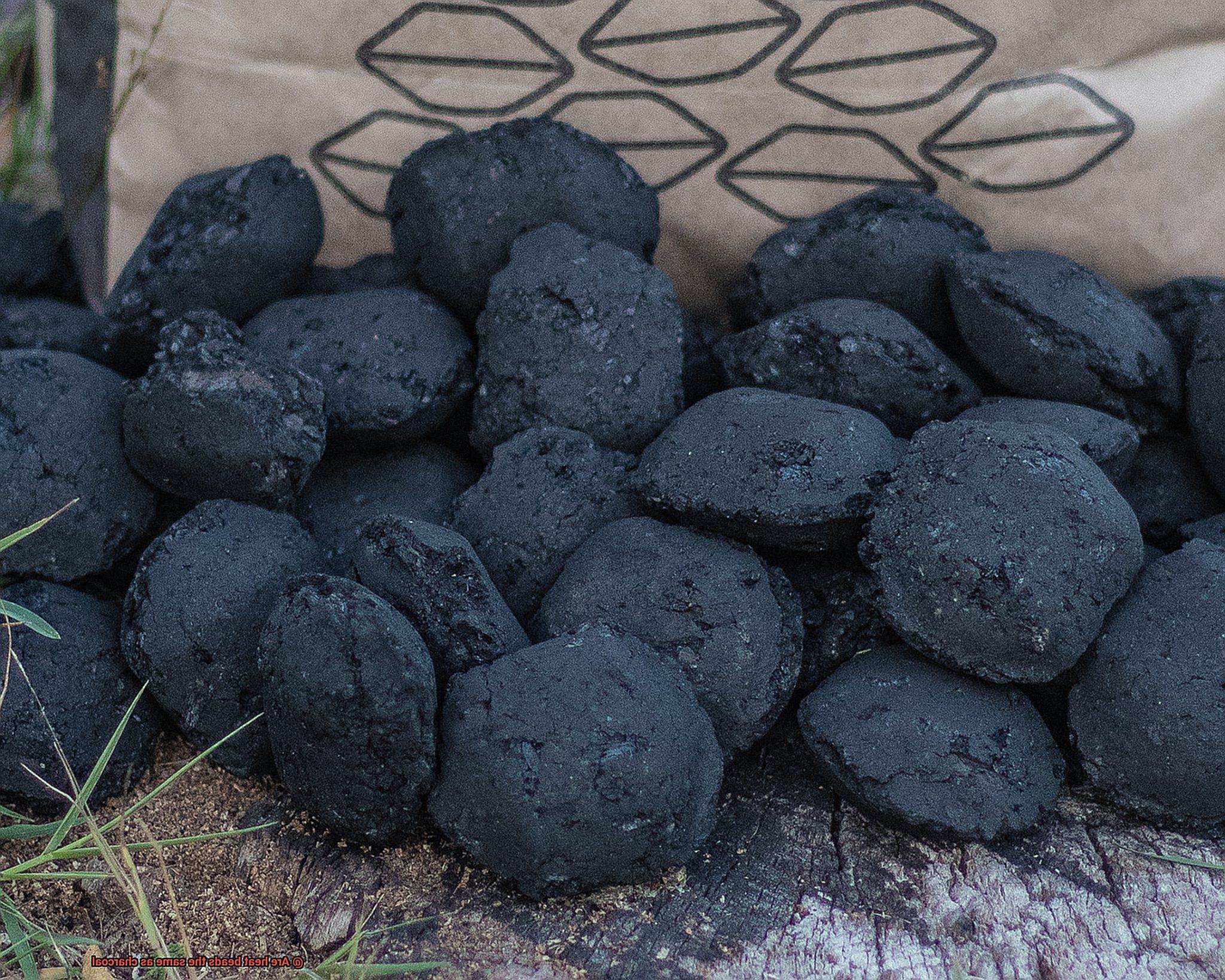
Thirdly, cost is a crucial factor to consider. Heat beads are generally more expensive; however, they can last longer and require less fuel to achieve the desired temperature. Charcoal, on the other hand, is generally cheaper but may require more frequent refueling.
Lastly, let’s talk about environmental impact. Heat beads are made from compressed sawdust and other wood products, making them a more eco-friendly option than traditional hardwood charcoal. However, some brands of charcoal use sustainable sources or recycled materials to reduce environmental impact.
Tips for Safe Grilling With Heat Beads or Charcoal
Grilling with heat beads or charcoal is a classic way to cook food and enjoy the outdoors. However, it’s important to take precautions and prioritize safety when using these fuel sources. Here are five tips for safe grilling with heat beads or charcoal:
Check your grill and surroundings
Before you start grilling, make sure your grill is in good condition and positioned on a stable surface away from any flammable objects. Keep in mind that heat beads and charcoal produce carbon monoxide, so grilling should only be done in a well-ventilated area.
Use the right amount of fuel
Using too much fuel can cause flare-ups and burning, while using too little can result in uneven cooking. Follow the recommended amount for your grill size and the amount of food you are cooking.
Light your fuel properly
Igniting heat beads or charcoal can be done safely using a chimney starter or electric starter. Avoid using lighter fluid or gasoline, as these can cause dangerous flare-ups and leave a chemical taste on your food.
Wait for the fuel to ash over
Once your fuel is lit, wait until it has ashed over before adding food to the grill. This will ensure even cooking and reduce the risk of flare-ups.
Stay safe while cooking
Keep a safe distance from the grill while cooking, use long-handled utensils to avoid burns, and never leave a lit grill unattended. If an emergency does occur, keep a fire extinguisher nearby.
BQIZ52EL14U” >
Conclusion
To sum it up, heat beads and charcoal are two distinct fuel sources that have their own unique characteristics. Heat beads, made from compressed sawdust, burn at a steady temperature with minimal smoke and ash production. They’re perfect for slow-cooking meats or smoking foods. Charcoal, on the other hand, burns hotter and faster than heat beads, making it ideal for searing steaks or cooking foods that require high heat.
When deciding between the two options, take into account various factors such as the type of food you’ll be grilling, cooking time, cost, and environmental impact. Safety should also be a top priority when using these fuels – ensure your grill and surroundings are safe before lighting up and use the right amount of fuel.
Ultimately, whether you prefer heat beads or charcoal depends on your personal taste and grilling style. Both can produce mouth-watering results when used correctly.

